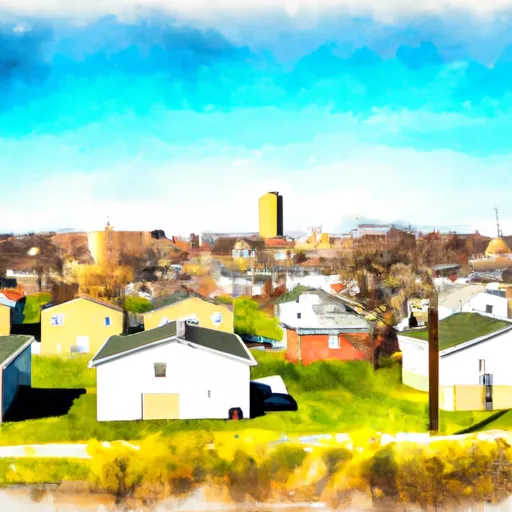-
 Snoflo Premium
Snoflo Premium
Get unlimited access to all our content
With no Ad interruptions! - Start Your Free Trial Login with existing account
Union-Hill
Eden Index
Climate
7.8
•
Recreation
3.8
•
Community
•
Safeguard
4.5/10

Located in the heart of Illinois, Union-Hill is a small village with a population of approximately 200 residents. The village experiences a continental climate, characterized by four distinct seasons. Summers are warm and humid, with temperatures averaging around 85°F, while winters are cold and snowy, with temperatures dropping below freezing. Spring and fall offer mild temperatures and colorful foliage, making them ideal seasons for outdoor activities.
The hydrology of Union-Hill is primarily influenced by the Kankakee River, which flows nearby. This river serves as a significant source of water for the village, providing opportunities for fishing, boating, and kayaking. The river's ecosystem is diverse, boasting various fish species like northern pike, catfish, and bass. The nearby Kankakee River State Park offers hiking trails, camping grounds, and scenic picnic areas, providing ample opportunities for outdoor recreation.
In addition to the river, Union-Hill is surrounded by beautiful countryside, offering opportunities for biking, bird-watching, and nature walks. The village itself is known for its charming rural landscapes and friendly community. Visitors and residents alike can enjoy the tranquil atmosphere and engage in various outdoor activities, fostering a deep appreciation for nature and the environment.
What is the Eden Index?
The Snoflo Eden Index serves as a comprehensive rating system for regions, evaluating their desirability through a holistic assessment of climate health, outdoor recreation opportunities, and natural disaster risk, acknowledging the profound impact of these factors on livability and well-being.
Climate Health Indicator (CHI): 7.8
Union-Hill receives approximately
947mm of rain per year,
with humidity levels near 82%
and air temperatures averaging around
10°C.
Union-Hill has a plant hardyness factor of
5, meaning
plants and agriculture in this region thrive during a short period during spring and early summer. Most
plants will die off during the colder winter months.
By considering the ideal temperature range, reliable water supplies, clean air, and stable seasonal rain or snowpacks, the Climate Health Indicator (CHI) underscores the significance of a healthy climate as the foundation for quality living.
A healthy climate is paramount for ensuring a high quality of life and livability in a region, fostering both physical well-being and environmental harmony. This can be characterized by ideal temperatures, reliable access to water supplies, clean air, and consistent seasonal rain or snowpacks.
Weather Forecast
Streamflow Conditions
Upper Illinois
Area Rivers
Upper Illinois
Snowpack Depths
Upper Illinois
Reservoir Storage Capacity
Upper Illinois
Groundwater Levels
Recreational Opportunity Index (ROI): 3.8
The Recreational Opportunity Index (ROI) recognizes the value of outdoor recreational options, such as parks, hiking trails, camping sites, and fishing spots, while acknowledging that climate plays a pivotal role in ensuring the comfort and consistency of these experiences.
Access to outdoor recreational opportunities, encompassing activities such as parks, hiking, camping, and fishing, is crucial for overall well-being, and the climate plays a pivotal role in enabling and enhancing these experiences, ensuring that individuals can engage in nature-based activities comfortably and consistently.
Camping Areas
| Campground | Campsites | Reservations | Toilets | Showers | Elevation |
|---|---|---|---|---|---|
| Boswell Landing | 34 | 406 ft | |||
| Sam Parr State Park | 80 | 524 ft | |||
| Mousetail Landing State Park | 24 | 429 ft | |||
| Piney - LBL | 300 | 385 ft | |||
| Hilltop Campground - Grayville | None | 391 ft | |||
| Beech Bend | None | 373 ft | |||
| Paris Landing State Park | 63 | 392 ft | |||
| Natchez Trace State Park | 50 | 637 ft | |||
| Nathan Bedford Forrest State Park | 53 | 437 ft | |||
| Rushing Creek - LBL | 56 | 402 ft |
Nearby Ski Areas
Catastrophe Safeguard Index (CSI):
The Catastrophe Safeguard Index (CSI) recognizes that natural disaster risk, encompassing floods, fires, hurricanes, and tornadoes, can drastically affect safety and the overall appeal of an area.
The level of natural disaster risk in a region significantly affects safety and the overall livability, with climate change amplifying these risks by potentially increasing the frequency and intensity of events like floods, fires, hurricanes, and tornadoes, thereby posing substantial challenges to community resilience and well-being.
Community Resilience Indicator (CRI):
The Community Resilience Indicator (CRI) recognizes that education, healthcare, and socioeconomics are crucial to the well-being of a region. The CRI acknowledges the profound impact of these elements on residents' overall quality of life. By evaluating educational resources, healthcare accessibility, and economic inclusivity, the index captures the essential aspects that contribute to a thriving community, fostering resident satisfaction, equity, and social cohesion.

